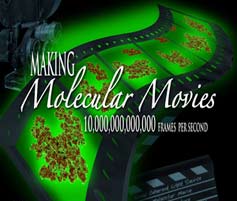

Monday - December 11, 2006
SLAC Today is
available online at:
http://today.slac.stanford.edu
In this issue:
Public Lecture: Making Molecular Movies
Director's Column
Sprucing up for the Holidays
Safety Firsts
 |
 |
|
Monday - December 11, 2006 |
Public Lecture: Making Molecular Movies
Image courtesy of SLAC InfoMedia Movies have transformed our perception of the world. With slow motion photography, we can see a hummingbird flap its wings, and a bullet pierce an apple. The remarkably small and extremely fast molecular world that determines how your body functions cannot be captured with even the most sophisticated movie camera today. To see chemistry in real time requires a camera capable of seeing molecules that are one ten billionth of a foot with a frame rate of 10 trillion frames per second. With the Linac Coherent Light Source (LCLS), SLAC has embarked on the construction of just such a camera. In tomorrow's public lecture, "Making Molecular Movies: 10,000,000,000,000 Frames per Second," Kelly Gaffney will discuss how this molecular movie camera will work and how it will change our perception of the world. The lecture takes place at 7:30 p.m. on Tuesday, December 12, in the Panofsky Auditorium. All are welcome to attend. |
||
|
|
||
 What an exciting week it's been. The lab has been humming with activity, and everyone must have felt a bit of the buzz—whether it was in the packed meeting rooms, the intense discussions on the walkways, or at the overflowing Linear Café. At the very least, everyone is sure to have noticed the very full parking lots. All this bustle is exciting not only for the energy it brings, but also because it indicates that SLAC is at the center of international research. The BaBar collaboration meeting successfully wrapped up on Saturday after five productive days. Collaborators discussed an abundance of recent physics results, this Fall's PEP-II upgrade work, the just-completed muon upgrade project and a preliminary report on the plan for analysis beyond September 30, 2008, when the detector is scheduled to stop taking data. The BaBar collaboration continues to be strong, shown by the large international turnout for this year's meeting. The number of languages heard onsite must have doubled during the past week. Across the quad, a very different kind of planning took place all last week in the Kavli Building, where more than 100 attendees of the LSST All-Hands meeting carefully considered how to build their program. Over the course of five days, the group discussed the funding, the structure, the engineering and, of course, the science of this ground-based telescope. This meeting was especially important for the collaboration not only because it was the largest yet, but also because it was the first to include non-U.S. scientists—a first step toward LSST becoming an international project. Finally, two South Arc Beam Experimental Region (SABER) reviews took place last week. SABER is the proposed relocation of the FFTB to the south arc of the SLC and would allow the lab to continue high energy electron beam experiments with very short, intense bursts of electrons or positrons. The Experimental Program Advisory Committee (EPAC) met early last week for an in-depth examination of the first experiments that would be done at SABER. The experimental proposals were well received by this international committee of high-level scientists from around the world. Later in the week, the Department of Energy brought a group of accelerator physicists to review the relocation proposal. They were complimentary of the plans and enthusiastic about the science opportunities of SABER. These reviews were an important step toward making SABER a reality, and I would like to thank everyone who participated for their hard work. —Keith Hodgson |
Sprucing up
|
Events (see all | submit)
Access (see all)
Announcements
|
| | ||
|
|
||
 <%
Response.AddHeader "Last-modified", getArticleDate()
'Response.AddHeader "Last-modified","Mon, 01 Sep 1997 01:03:33 GMT"
'Monday, December 06, 2010
%>
<%
Response.AddHeader "Last-modified", getArticleDate()
'Response.AddHeader "Last-modified","Mon, 01 Sep 1997 01:03:33 GMT"
'Monday, December 06, 2010
%>View online at http://today.slac.stanford.edu//. |
||